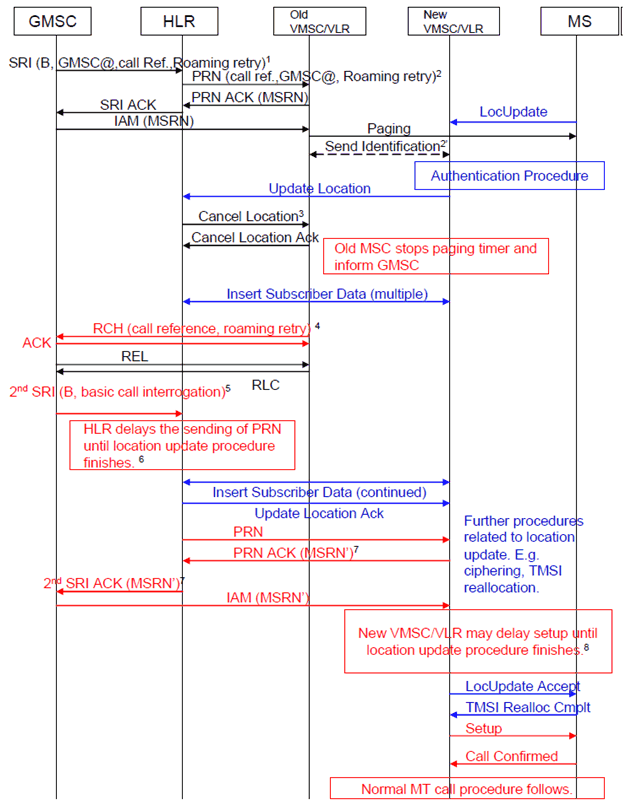Content for TS 23.018 Word version: 17.0.0
5.2.1 Mobile Terminating Roaming Retry Call after successful Retrieval of Routeing Information |R7| p. 18
The information flow for mobile terminating roaming retry call after successful retrieval of routeing information is shown in Figure 4a. It applies to a mobile terminating call while the called mobile is simultaneously moving from an old to a new MSC, if the GMSC, the HLR and the old terminating VMSC support the MT Roaming Retry procedure.
In that case, upon receipt of:
- an ISUP IAM message which was preceeded by a MAP Cancel Location procedure, or
- a MAP Cancel Location procedure while on-going paging,

Figure 4a: Information flow for a mobile terminating roaming retry call after successful Retrieval of Routeing Information
(⇒ copy of original 3GPP image)
(⇒ copy of original 3GPP image)
Step 1.
Similarly, a HLR supporting the "mobile terminating roaming retry" feature should wait for the completion of any on-going Location Update procedure when processing other terminating requests e.g. MAP-SEND-ROUTING-INFO-FOR-SM, MAP-SEND-ROUTING-INFO-FOR-LCS, MAP-ANY-TIME-INTERROGATION. More generally, this also applies to all TCAP transactions that the HLR may have to open toward a VLR (e.g. USSD, PSI).
A GMSC supporting the "mobile terminating roaming retry" feature includes the Call Reference Number, the GMSC address and the MT Roaming Retry Supported IE in the first SRI sent to the HLR.
Step 2.
A HLR supporting the "mobile terminating roaming retry" feature includes the Call Reference Number, the GMSC address and the MT Roaming Retry Supported IE in the PRN sent to the MSC/VLR if received in the SRI.
Step 2'.
An old VLR supporting the "mobile terminating roaming retry" feature may indicate in the MAP Send Identification response sent to the new VLR whether there is a pending mobile terminating call at the old VLR.
Step 3.
Receipt of the MT Roaming Retry Supported IE in the PRN indicates that the GMSC supports the Resume Call Handling procedure and the mobile terminating roaming retry feature. Upon receipt of the ISUP IAM message which was preceeded by a MAP Cancel Location message, or upon receipt of the MAP Cancel Location message while paging, the old MSC/VLR stops paging, if paging was on-going, and if it supports the "mobile terminating roaming retry" feature and did receive the MT Roaming Retry Supported IE in the PRN, sends an RCH message to the GMSC with the MT Roaming Retry IE. The old MSC shall terminate any open CAP dialogue when receiving RCH ACK or ISUP REL message.
Step 4.
Upon receipt of the RCH message with the MT roaming retry IE, the GMSC acknowledges the RCH message, releases the call towards the old MSC/VLR, terminates T-CSI dialog with the SCP, if any exists, using T-Abandon EDP, and re-sends a new SRI to the HLR (still a 'basic call' interrogation type) using a new call reference number.
Step 5.
To avoid looping, the new SRI shall be sent without the Roaming Retry Supported IE. Furthermore, the GMSC shall use an appropriate high value for the timer supervising receipt of SRI ACK.
Note that the Suppress T-CSI field is not set since the Mobile Terminating procedure is restarted from the beginning including the handling of CAMEL interaction on T-CSI (this is because T-CSI treatments may end differently if old and new MSCs are not in the same PLMN or in the same geographical area, e.g. different charging rates or regional service subscription).
Step 6.
Upon receipt of a SRI request or PRN ack (regardless of the PRN response from the old VLR) during an on-going Update Location procedure, the HLR delays the sending of the PRN to the new VLR till completion of the Update Location procedure.
Step 7.
Receipt of the MSRN' from the new MSC/VLR enables the GMSC to relay the call towards the new MSC/VLR.
Step 8.
If the IAM message is received before the Location Update procedure is completed with the MS, the new MSC may delay the setup of the call until the completion of the Location Update procedure or start at once the normal terminating call procedure. In the former case, if the Location Update is received with the "follow-on" indication and if the VMSC supports the "follow-on" indication, the incoming IAM may either be handled as a waiting call or forwarded as Busy (CFB), depending on the state of the "follow-on" call and the subscriber's subscription data.
If no IAM message has been received at the time the Location Update procedure completes, the new MSC may shortly defer the release of the signalling connection with the MS if the old VLR indicated in the MAP Send Identification response that there is a pending mobile terminating call at the old VLR.